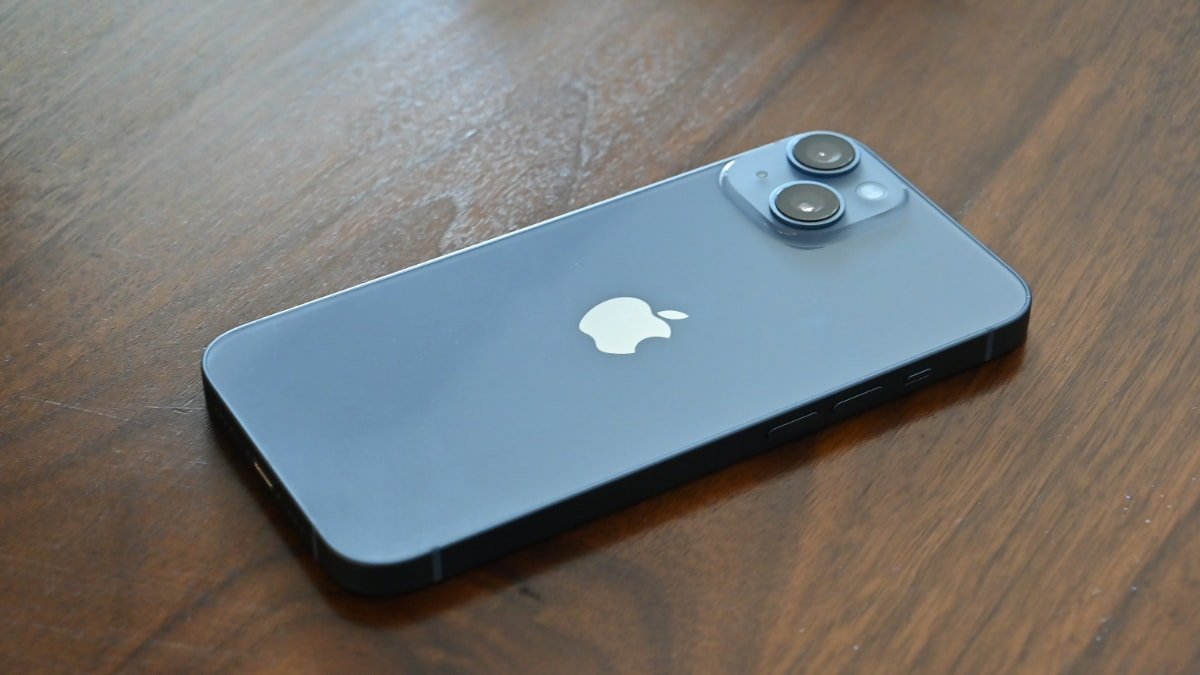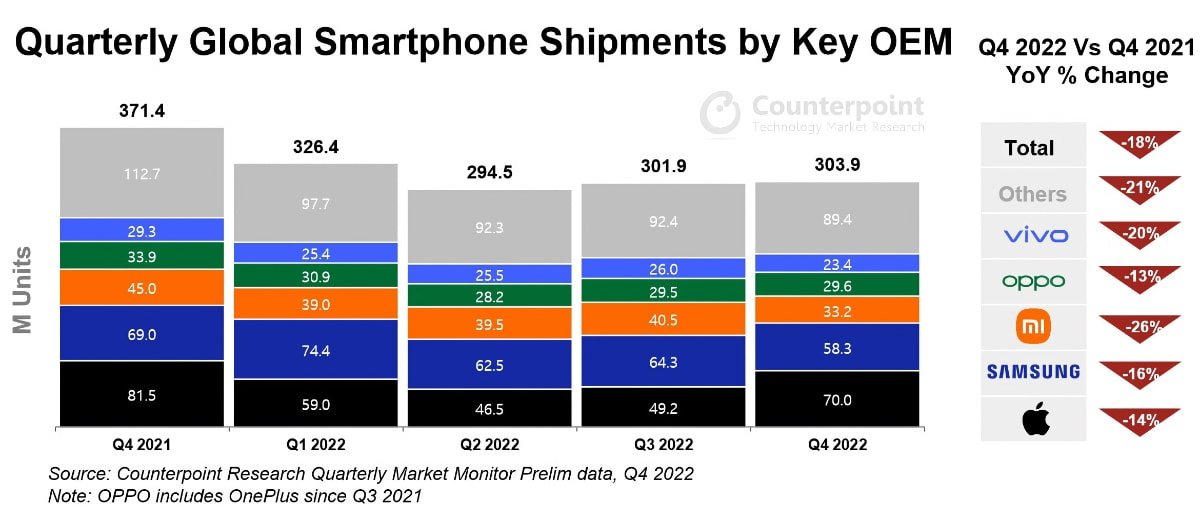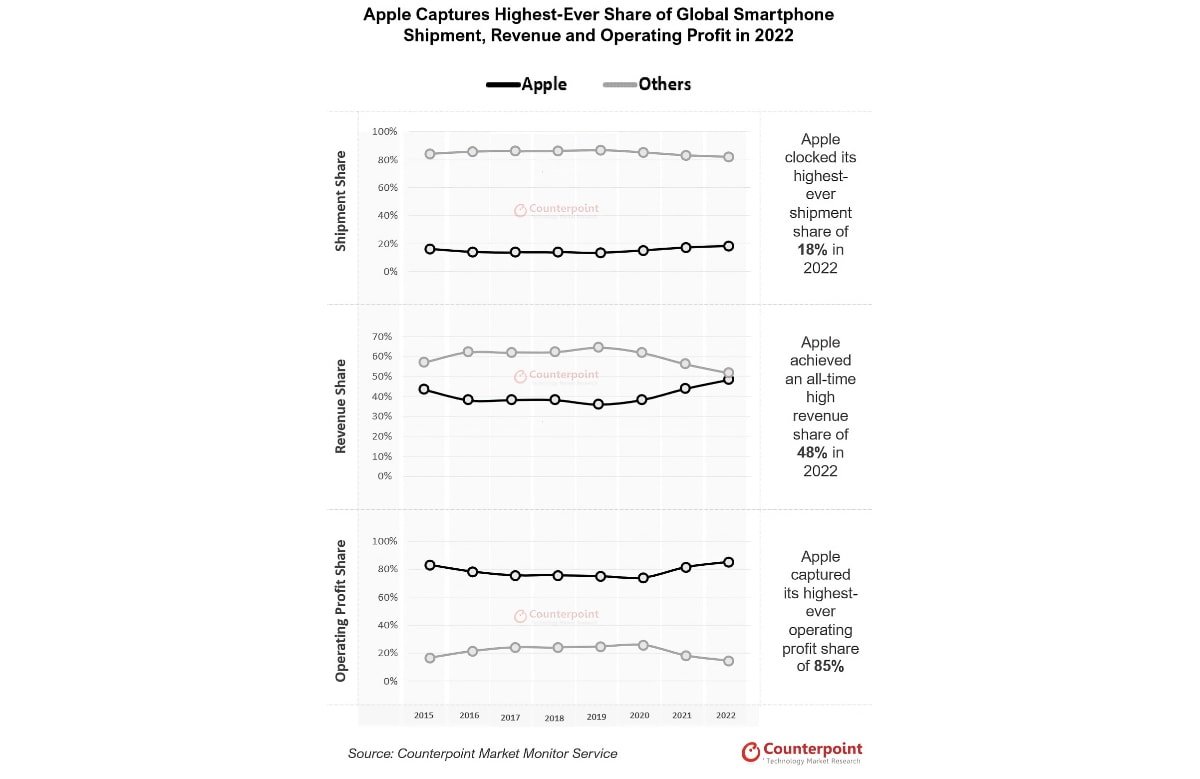Apple collects nearly all of the profit in the worldwide smartphone market
In 2022, Apple's operating profit share of the worldwide smartphone market reached a recent high of 85%, and the company shipped 70 million iPhones in the fourth quarter.

iPhone 14
Driven by sales of the iPhone 14 launched in September, Apple has achieved its highest-ever global smartphone shipment, revenue, and operating profit share in 2022.
Although Apple's shipments, revenue, and operating profits declined year-over-year in quarter four of 2022, it still captured 18% of shipment share, 48% of the revenue of the marketplace, and 85% of the profit generated by the segment for the year.
The company shipped 70 million iPhones in the fourth quarter, up from 49.2 million in quarter three but down from 81.5 million units in quarter four of 2021. Apple's manufacturing issues in China and not demand are the culprits for the lower shipment numbers.
According to the latest analysis from Counterpoint Research, the global smartphone market saw an 18% year-over-year decline in shipments in quarter four of 2022, the lowest level for a holiday quarter since 2013. Shipments for the entire year declined to 1.2 billion units, also the weakest since 2013.

Global smartphone shipments in 2022. Source: Counterpoint Research
However, shipments grew by a minuscule 1% quarter-over-quarter to 303.9 million units.
Research Director Jeff Fieldhack commented on Apple's success in a market crushed by external forces.
"Having proficiently managed its production problems, Apple was able to weather a year already marred by economic and geopolitical turmoil better than other major smartphone players," Fieldhack said. "Its iPhone Pro series continued performing well and its share of iPhone shipments could have been even higher if not for the production issues caused by the COVID-19 breakout at the Zhengzhou factory, which produces the vast majority of Pro series volumes. As a result, some Pro series volumes got pushed to January."

Apple won the top spot in 2022. Source: Counterpoint Research
Meanwhile, in the first quarter of 2023, Apple reported $117.15 billion in revenue, a decline from $123.9 billion in quarter one of 2022. The iPhone brought in $65.78 billion in revenue for the quarter, down from the $71.6 billion in the year-ago quarter.
Less than a decade ago, Apple collected more profit from the smartphone market than was strictly generated in total, if the losses that most Android manufacturers were seeing was incorporated into the calculation.
Read on AppleInsider

iPhone 14
Driven by sales of the iPhone 14 launched in September, Apple has achieved its highest-ever global smartphone shipment, revenue, and operating profit share in 2022.
Although Apple's shipments, revenue, and operating profits declined year-over-year in quarter four of 2022, it still captured 18% of shipment share, 48% of the revenue of the marketplace, and 85% of the profit generated by the segment for the year.
The company shipped 70 million iPhones in the fourth quarter, up from 49.2 million in quarter three but down from 81.5 million units in quarter four of 2021. Apple's manufacturing issues in China and not demand are the culprits for the lower shipment numbers.
According to the latest analysis from Counterpoint Research, the global smartphone market saw an 18% year-over-year decline in shipments in quarter four of 2022, the lowest level for a holiday quarter since 2013. Shipments for the entire year declined to 1.2 billion units, also the weakest since 2013.

Global smartphone shipments in 2022. Source: Counterpoint Research
However, shipments grew by a minuscule 1% quarter-over-quarter to 303.9 million units.
Research Director Jeff Fieldhack commented on Apple's success in a market crushed by external forces.
"Having proficiently managed its production problems, Apple was able to weather a year already marred by economic and geopolitical turmoil better than other major smartphone players," Fieldhack said. "Its iPhone Pro series continued performing well and its share of iPhone shipments could have been even higher if not for the production issues caused by the COVID-19 breakout at the Zhengzhou factory, which produces the vast majority of Pro series volumes. As a result, some Pro series volumes got pushed to January."
Apple wins the top spot
Apple's product line is entirely situated in the premium segment of the market, which was less affected by economic and geopolitical uncertainties. Because they last a long time, many smartphone users have been preferring to purchase premium devices.
Apple won the top spot in 2022. Source: Counterpoint Research
Meanwhile, in the first quarter of 2023, Apple reported $117.15 billion in revenue, a decline from $123.9 billion in quarter one of 2022. The iPhone brought in $65.78 billion in revenue for the quarter, down from the $71.6 billion in the year-ago quarter.
Less than a decade ago, Apple collected more profit from the smartphone market than was strictly generated in total, if the losses that most Android manufacturers were seeing was incorporated into the calculation.
Read on AppleInsider

Comments
Which means of course, that Apple (and Samsung) are pretty much the only phones sold at a high margin, which in turn translates into high profit. It isn’t just a mark of volume (well, 14% market share is reasonably popular), but how big a difference there is between costs and wholesale price. And to completely beat out everyone else on margins.
What do you mean by "we are all paying for this metric"? Are you saying that we're being overcharged if Apple is making a profit? If so, you need to look at why others aren't making a profit as well as what drives you as a customer to buy or not to buy a product from Apple, Samsung, or another vendor.
Personally, I only look at how a given product will affect my bottom line. I could do like many others and buy a $500 WinPC every 12 months knowing the vendor will get very little (if any) direct profit from that sale, which then requires me to waste time setting up, which also includes removing installed crapware and buying 3rd-party apps -or- I could spend $3k on a Mac every 4 years that is quick to setup, requires very little additional paid SW (in comparison), and allows me to complete tasks more efficiently (in comparison) that then yields me a lower TCO over all those kludgy WInPCs. Whether or not Lenovo or Apple make a profit on my purchase is irrelevant when my goal is how the purchase affects the increase or decrease of my wallet (and my stress and time wasted) over its lifetime.